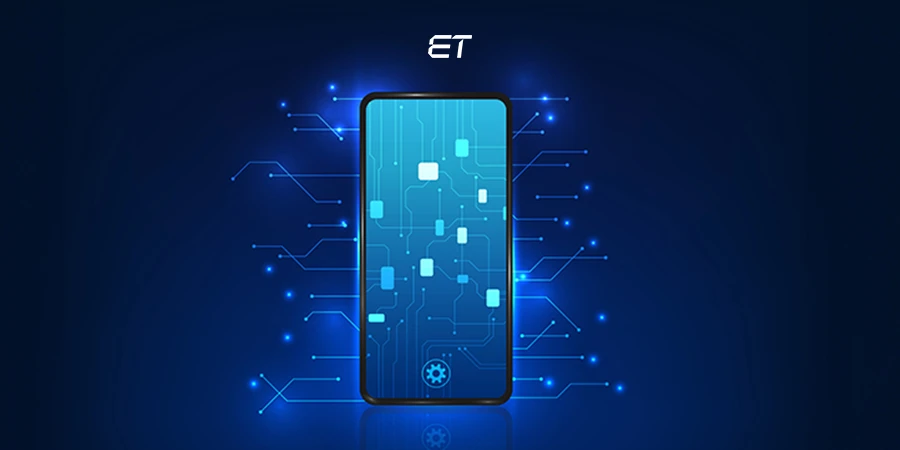
Outsource Mobile App Development: Making Sense for Your Business
You think of launching a new app. The team’s ready. Your idea is solid. Then, you study the market.
And bam! There are nearly 9 million mobile apps already.
Still, you are optimistic. You build, test, and launch. But something goes wrong down the line.
Your team burns out. Post-launch fatigue, scaling issues, or knowledge gaps start slowing progress. That’s when you feel, ‘maybe it was the right time to outsource mobile app development.’
It’s true. Outsourcing isn’t all about saving bucks.
It’s a tactic to keep the product moving. And as a business, you need to know why this decision is a wise one. Our blog sheds light on mobile app development outsourcing in a different way.
Scroll ahead to find out why this strategy isn’t optional anymore.
Why to Outsource Mobile App Development (It Isn’t Just Cost Savings)
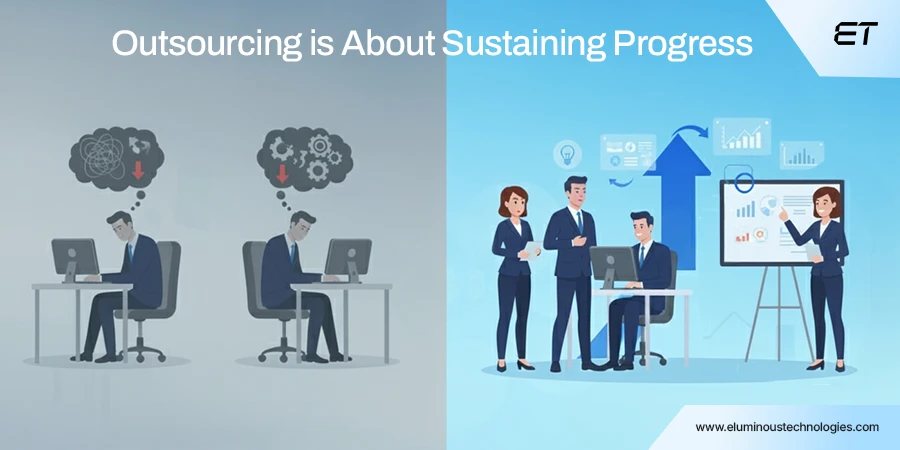
Let’s get right to the chase.
The mobile app outsourcing market is on a boom. By 2030, its valuation can reach USD 124 billion. The number points out one thing – companies are outsourcing and will continue to do so.
But is cost-savings the biggest reason?
In a word, no.
Don’t get us wrong. Cost savings matter. In fact, teaming up with an offshore software development partner can cut costs by 40%.
Still, in 2025 (and beyond), cost reduction is a by-product. Here are other perks you get from outsourcing mobile app development:
- You save time
- You get specialized skills
- You maintain post-launch momentum
- You get a global perspective
- You scale up and down (without headache)
- You save costs (no brainer)
And it’s not just startups or mid-scale companies. Google, Netflix, Adidas, Walmart, etc., use third-party services. Now, let’s explain each reason in depth.
1. Saving Time
This advantage might be cliché, but it’s still significant.
When you outsource mobile app development, the extended team frees your bandwidth. You can focus on product strategy, UX, and growth.
The outsourcing partner handles coding, QA, and other technical activities. So, when someone says outsourcing saves time, it’s more about optimization. You don’t necessarily code faster, but the final launch becomes quicker.
2. Accessing Specialized Skills
Flutter, Kotlin, AI, AR, and the list goes on. It’s tricky to hire mobile app developers skilled in every tech.
In addition, you can’t overburden your existing team. So, the quick fix?
Outsourcing. By hiring specialized developers, you get ready-made expertise on demand.
3. Maintaining Momentum
This point is the most underrated benefit of outsourcing mobile app development.
The biggest slowdown doesn’t happen when you develop an app. You notice this lag after launch. How?
- New feature requests start piling up
- The backlog keeps growing
- Your in-house team is busy with analytics setup
All of a sudden, the speed drops. And you fall behind. That’s when an outsourcing partner fills the gap.
4. Gaining a Global POV
You want to develop a global app?
Then hire global talent. This statement isn’t just a fancy line. It makes sense.
- Your in-house team operates within the same market
- The mindset, education, and environment are familiar
- This familiarity leads to stagnation in ideas and execution
But what happens if you choose an overseas mobile app development vendor?
You get cross-industry and cultural experience. For example, an Indian service provider can bring a unique perspective on rapid prototyping. A European partner can suggest niche GDPR-centric design thinking.
When you outsource mobile app development globally, you gain collective intelligence.
5. Scaling at Will
An outsourcing partner offers flexibility. You can hire 4 developers for 6 months and reduce the team size to 2 later. For the QA phase, you can hire 2 quality engineers and keep the momentum going.
Notably, there are no HR formalities or finding the right talent. So, this advantage makes outsourcing a convenient option.
6. Saving Costs
It’s true that outsourcing helps reduce expenses. But you should perceive it as a high-value investment.
Don’t think outsourcing is a discount coupon. At comparatively low cost, you get:
- Time
- Speed
- Expertise
- Scalability
This decision builds long-term value. Your app hits the market two months earlier, user churn drops quickly, and collaboration improves workflow. All these aspects save costs – direct and indirect.
Why ‘Now’ is the Right Time to Outsource Mobile App Development?
You’ll read many blogs stating how outsourcing is effective than in-house hiring. The info is useful. But a few of them show you why the time’s right.
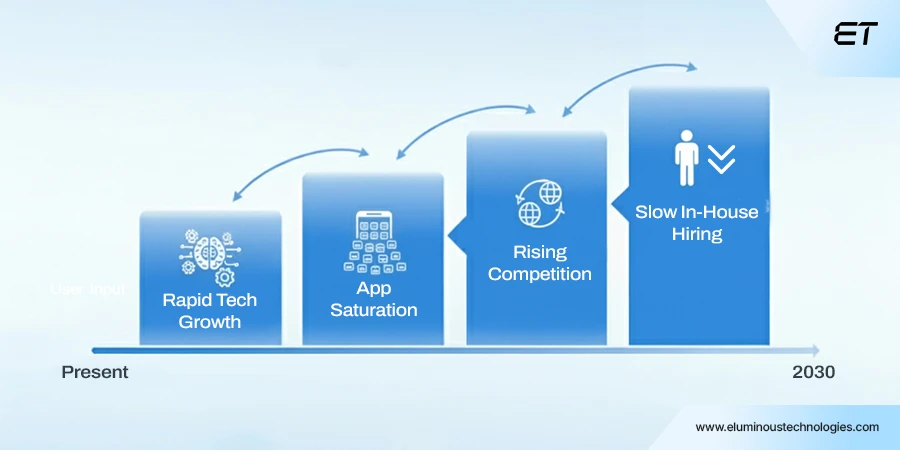
In this section, we’ll explain the main reasons:
- The App Market is Crowded: There are nearly 9 million apps out there. You can launch one more and lose yourself maintaining it. Or you can outsource, build a unique one, and iterate fast.
- In-house Hiring Needs Time: According to MoldStud, you might spend 12 – 18 weeks hiring an app developer. This timeline includes research from scratch to the final negotiation. Outsourcing saves this valuable time.
- Tech’s Evolving Fast: AI, blockchain, RAG, the names keep coming. Outsourcing teams work on diverse projects. So, they are up-to-date with the new technologies, helping you align with the trends.
- You Need to Launch Before the Others: Speed or time-to-market matters a lot in today’s age. The sooner you release, the faster you learn, improve, and build a user base before anyone else.
By 2031, the AI market value can reach up to USD 1.68 trillion. Surely, you want to make the most of these promising years. Mobile app development outsourcing can be a defining choice for this purpose.
What You Gain from Outsourcing Mobile App Development
By now, you know one thing – even the strongest teams can benefit from outsourcing. But what are the overall gains? The table below explains them without fluff.
| Benefit | Why It Matters for Your Business |
| Faster Time-to-Market | Fast-track release cycles and test ideas before competitors. |
| Access to Global Expertise | Use diverse technical and cultural perspectives for a more scalable, inclusive product. |
| Scalability on Demand | Add or reduce resources easily without hiring hassles. |
| Reduced Operational Overheads | Avoid long-term payroll, infrastructure, and training costs. |
| Continuous Innovation | Keep your app evolving even when your internal team’s focus shifts. |
| Risk Reduction | Shared accountability ensures fewer bottlenecks and more predictable delivery. |
| Strategic Focus | Free your core team to focus on business strategy and user experience. |
The Roadmap to Outsource Mobile App Development
On the surface, every outsourcing strategy sounds the same:
- You research the top companies
- Then, shortlist the most promising ones
- Book a consultation call
- Send a request for proposal
- Analyze the response
- Negotiate and sign an NDA
- Start the mobile app development
But in each step, you should pay attention to some core elements. In this section, we’ll explain them one by one.
1. Know Your In-house Facets
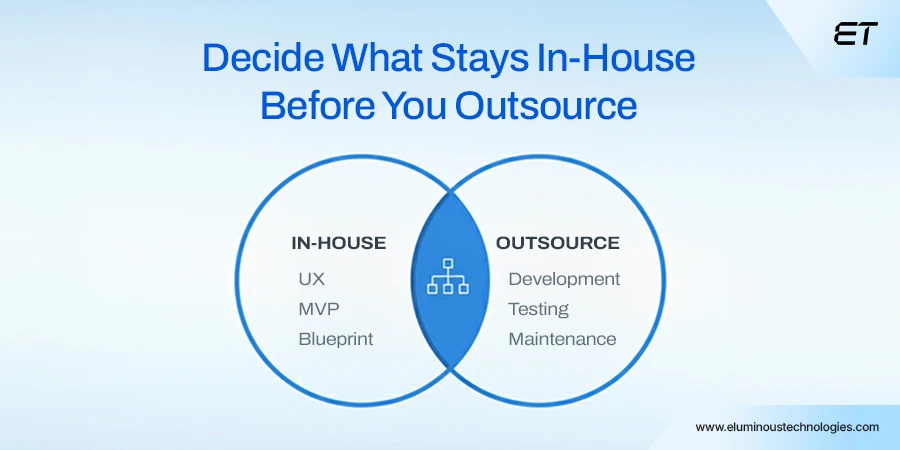
Before going outwards, decide what stays inside.
For instance, you would want your UX, minimum viable product (MVP), or blueprint within your team’s control.
Other activities like design execution, development, testing, and maintenance can go to the outsourcing vendor. This way, you are clear on three aspects:
- Scope
- Ownership
- Expectations
Overall, the best outsourcing partnership starts with well-defined boundaries. This clarity saves time for you and helps the overall collaboration.
2. Choose the Right Model
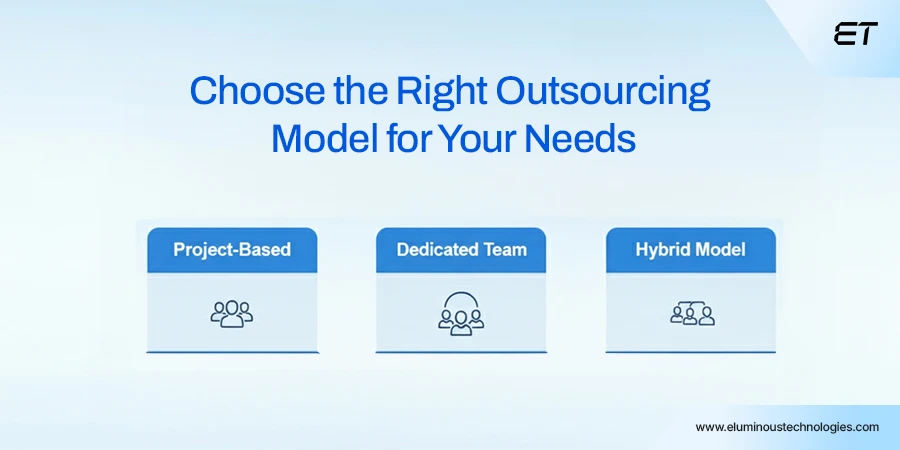
You’ll come across three prominent models when you outsource mobile app development:
- Project-based: The outsourcing partner takes ownership of delivery from start to finish.
- Dedicated Team: The partner manages staffing, workflow, and delivery.
- Hybrid Model: Your outsourced developers handle backend, integrations, or testing. Strategy, design, and direction stay in-house.
You should choose a model in specific situations. Refer to the table below:
| Situation | Best-Suited Outsourcing Model | Why It Works |
| You have a clear, time-bound project (like an MVP or feature module). | Project-Based Model | Offers end-to-end delivery with predictable timelines |
| You need to continuously build, scale, and update your app post-launch. | Dedicated Team Model | Gives long-term stability and team consistency |
| Your in-house team handles strategy but lacks bandwidth for execution-heavy tasks. | Hybrid Model | Balances control and efficiency |
| You’re testing a new product idea or market fit with limited budget. | Project-Based Model | Lets you validate fast without long-term commitment |
| You want to scale fast without hiring full-time employees. | Dedicated Team Model | Enables instant scaling and smoother onboarding |
| You expect project requirements to evolve over time. | Hybrid Model | Provides flexibility to reallocate tasks |
3. Select a Suitable Outsourcing Partner
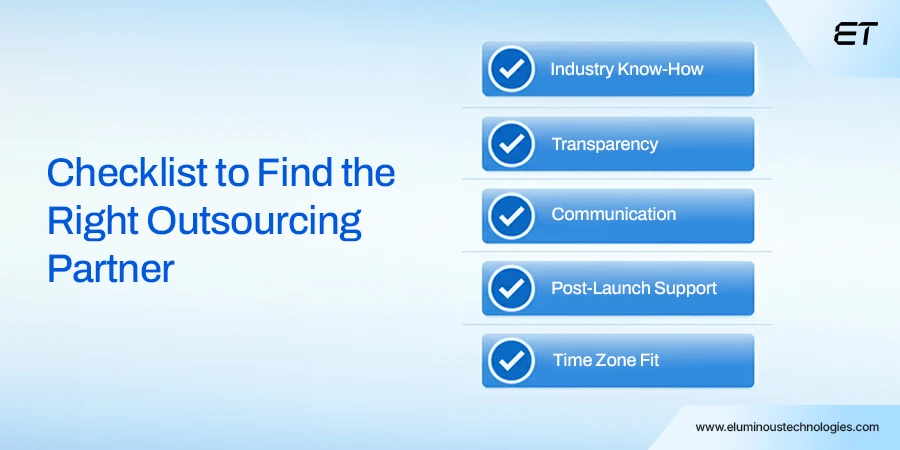
Don’t choose cheap code. Focus on a partner who gets your vision.
- Look beyond the official website
- Scan case studies and testimonials
- Ask questions to get their technical breadth
- See if they value an open line of communication
- Check if they have a dedicated manager proficient in English
- Enquire about the post-launch support framework
A request for proposal (RFP) is an excellent document. Send this doc to your shortlisted outsourcing partners. This way, you can compare the final choices.
Below, you’ll find an easy checklist to choose the right outsourcing partner:
| What to Check | Why It Matters |
| Industry Know-How | Cuts your learning curve |
| Tech Flexibility | Future-proofs your app when you scale |
| Transparent Processes | You always know progress and blockers |
| Post-Launch Support | Keeps your app alive and improving after release |
| Time Zone Fit | Faster decisions, fewer delays, smoother sync-ups |
| Client Retention | Real sign of trust (happy clients don’t switch) |
| Security Readiness | Protects user data and avoids compliance issues |
| Agile Workflow | Ensures steady progress and quicker iterations |
| Scalable Team | Let’s you expand fast without hiring chaos |
| Clear Communication | Saves time, money, and reduces stress |
4. Start Small, Scale Later
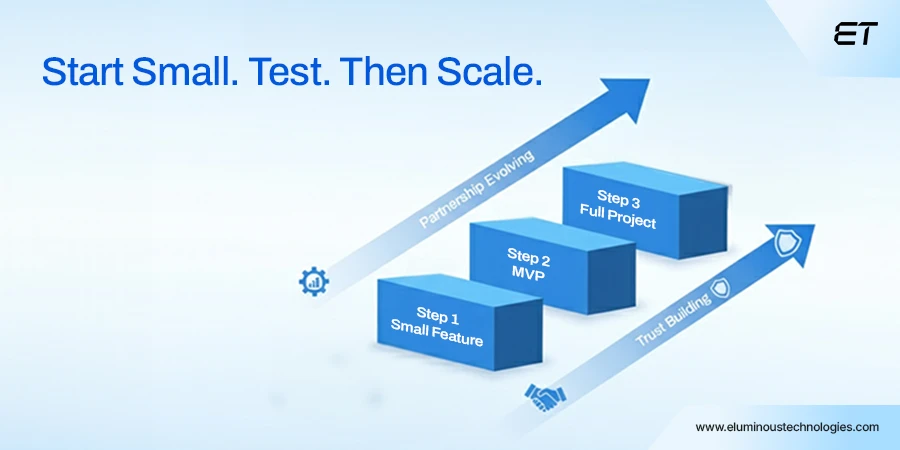
Don’t go all in on day one. That’s the golden rule to follow when you outsource mobile app development.
First, build a feature
- Next, tell your outsourcing partner to build an MVP
- Test the execution and rapport
- Check how the partner responds
These gradual steps lay the foundation for a long-term partnership. And it works.
- You minimize risk while building trust
- You get a hands-on sense of their work ethic
- You ensure both teams sync before money and time start compounding
So, always go one sprint at a time. Then, proceed to bigger projects or timelines.
5. Keep Collaboration Transparent
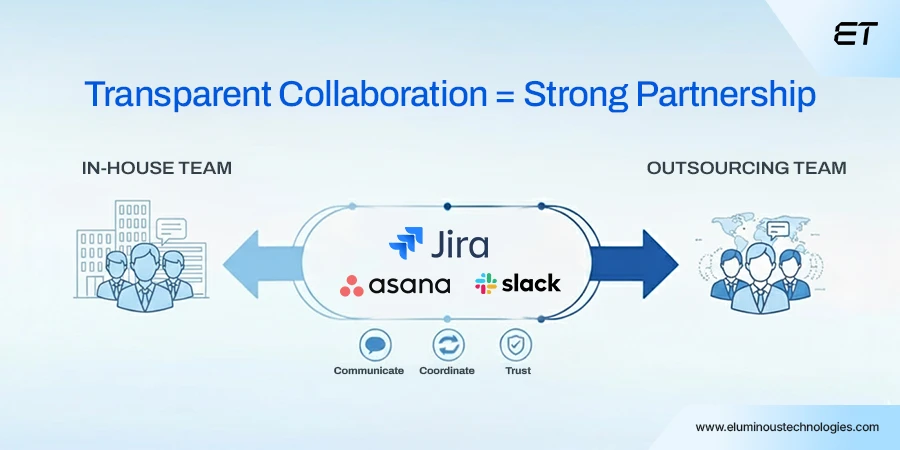
Outsourcing doesn’t mean you hand over the entire workflow.
This strategy focuses on shared visibility. You should make your vendor feel an extension of your team. For this purpose, you can:
- Use tools like Jira, Notion, or Asana
- Organize weekly sprints and progress demos
- Create direct Slack or Teams channels for quick feedback loops
Basically, everyone should know what’s happening. Your in-house team and outsourcing squad must be in sync.
The best part? In this stage, you’ll know if the outsourcing team is right for you.
If they resist open reporting, that’s a red flag. Also, if they hide some details under the ‘internal updates’ tag, it’s a no-go.
Staff augmentation or in-house? Which is the right pick for you?
6. Track Results, Not Hours
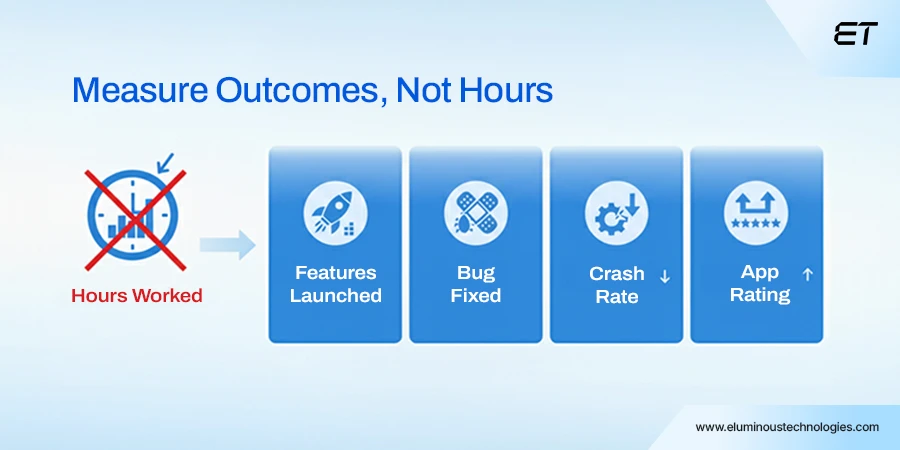
As a business, you might outsource mobile app development on an hourly basis.
This model can seem fine initially. But it makes no sense if the vendor works several hours without impact.
You should define outcome-based metrics. Here are a few to note:
- App ratings
- Number of bugs
- Retention rate
- Release time
Basically, instead of ’40 hours of coding,’ you focus on ‘4 new features launched.’ Or ’28 hours spent on QA’ becomes ‘20% reduced crash rate after release.’
The focus should always be on the bigger goal.
7. Finally, Keep Learning and Improving

Outsourcing today is basically a team extension. And you don’t hire a team to offboard after 2 projects.
So, you should work with your outsourcing partner as a long-term asset.
- Arrange review cycles
- Discuss user feedback
- Analyze performance data
- Assess your priorities
Learn new additions in the process of continuous innovation. Use your mobile app outsourcing decision as a partnership. This way, you turn an outsourced team into your no-fuss remote collaborator.
The Cost of Outsourcing Mobile App Development
There’s no fixed cost in the outsourcing model. Factors like location, tech stack, experience, and project complexity influence the final quote.
Still, you need to have a fair idea of the range. Below, you’ll find some approximates.
| Region | Typical Hourly Rate (USD) |
| South/Southeast Asia (e.g., India, Philippines, Vietnam) | $20 – $50/hr |
| Eastern Europe (e.g., Poland, Ukraine, Romania) | $30 – $70/hr |
| Latin America (e.g., Mexico, Brazil, Colombia) | $30 – $65/hr |
| North America / Western Europe (on-shore) | $70 – $150+/hr (depending on role & complexity) |
Why Rates Vary?
- Region/cost of living /wage levels: Places with lower wages tend to have lower rates
- Seniority & specialization: Senior developers, niche tech (AI, AR/VR, blockchain) cost significantly more
- Project complexity & tech stack: Native mobile apps, heavy integrations, multiple platforms, spike rates
- Engagement model: A dedicated team or long-term contract might have a different effective rate than a short project
- Vendor quality & reputation: A vendor with strong processes, certifications, and niche domain experience will command higher rates
Note: The hourly rates mentioned above are approximate averages compiled from multiple industry sources and practical outsourcing experience. Actual costs may vary depending on your app’s complexity, chosen tech stack, vendor expertise, and engagement duration. Use these figures as directional benchmarks, not final quotations. Always request detailed estimates from potential partners before making a decision.
Outsource Mobile App Development or Build In-house?
Before we wrap up, let’s address a common dilemma.

Should you outsource for most projects?
Frankly, there’s no straightforward ‘yes’ or ‘no’ answer. It depends on the situation. The table below can help clarify things.
| Situation | Best Choice | Why It Works |
| You’re testing an MVP or early-stage concept | Outsource | Quick delivery, lower risk, and minimal fixed costs |
| You have strict data security or compliance needs | In-House | Better control over sensitive data and regulatory policies |
| You plan continuous updates, feature releases, and scaling | Hybrid | Your internal team drives strategy; the outsourced one executes |
| You lack mobile-specific or niche technical expertise | Outsource | Instant access to talent in Flutter, React Native, or AI integration |
| You’re entering a new market or experimenting with a new tech stack | Outsource | You capitalize on global experience without long-term hiring |
Treat outsourcing as reinforcement. Mix it up. If you choose an apt vendor to outsource mobile app development, keep them in the loop. The partnership will be fruitful in the long run.
Wrapping Up: Be Tactical in Mobile App Outsourcing
The decision to outsource mobile app development isn’t easy. You want an extended team, not another temporary vendor.
To begin with, it is essential to understand that outsourcing offers more than just cost savings. The right vendor improves time-to-market, provides developers with niche skills, and helps maintain momentum. You also benefit from global expertise, the ability to scale as you wish, and save overhead in the long run.
But, to begin with, you need to be aware of your in-house needs. Then, choose the right engagement model, and select a suitable outsourcing partner. Start with a small project and expand gradually. Keep collaborating and communicate the main details transparently.All in all, treat outsourcing as an expert extension. This way, you augment your capability.
Ready to keep your app’s momentum going?
Frequently Asked Questions
1. What is the best time to outsource mobile app development?
You can choose to outsource when your in-house team hits bandwidth limits or lacks niche expertise. Outsourcing early ensures momentum without hiring delays.
2. How do I choose the right outsourcing partner for my app?
Look beyond pricing. Assess communication, past work, post-launch support, and team flexibility. A good partner will feel like a remote extension of your team, not a third party.
3. Is outsourcing risky for data security?
Not if done right. Reputed vendors follow strict NDAs, access controls, and compliance standards (like ISO or GDPR). Always check their security readiness before onboarding.




